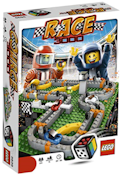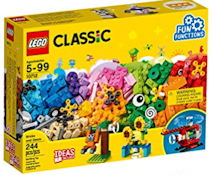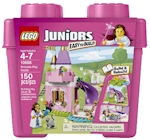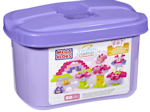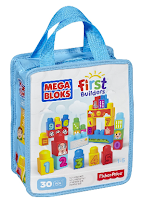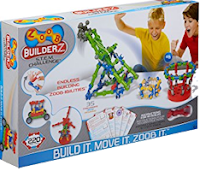 |
Building Skills with Construction Toys |
- They offer the opportunity to target and practice a wide range of skills naturally in one project including motor, visual perceptual, cognitive, and play and leisure.
- They offer a natural opportunity to follow directions, sequence, and apply logic to problem solve.
- They include a variety of directions for kids to follow, from step-by-step, to building from a completed model seen from only one perspective.
- They encourage creativity.
- They have a high play value - once the models are completed the fun has just begun.
- They can be used over and over and something new and different can be built each time you play with them.
- They end up being quite inexpensive considering their replay value.
I have blogged about a number of construction toys, and of course I have my favorites. Below is a list of the construction sets I own and have used most often. At the very bottom I will include some of the images of the sets I have blogged about. Just click on any one to go to the post about that set.
LEGO - My favorite construction sets, hands down. Extremely popular with the kids, these sets include pieces that come in many shapes, but center around models that are created with predominantly square and rectangle shaped pieces.
LEGO pieces are brightly colored plastic, non-pliable and solidly constructed, and pieces from one LEGO/LEGO Junior set will work with any other LEGO/LEGO Junior set. Some of the pieces are quite small, and can require precise fine motor skills to manipulate. I have a few different knock-off sets but rarely bring them out. There is always a subtle difference about the feel and the way the pieces snap together that keeps bringing me back to the LEGO line.
LEGO sets include step-by-step assemble guides which are easier to follow than guides that require you to build from only a picture of a finished model. With most new steps in a LEGO guide, the pieces are already added to the model. Some guides show these pieces in a different color, so it is easy to see where the new pieces go, and some don't. I like the pictures that don't make the new pieces obvious so that I can ask "What is new?" or "What has been added"?
To my knowledge, until the LEGO 3 in 1 sets came out, each LEGO set would include instructions for making one item, or 1 playset of items. The 3 in 1 sets have instructions for making three totally different items from the same set of blocks. A great value.
LEGOs offer so many different sets, including seasonal and holiday, that you will almost surely find something you like. They also have a line for young ladies called LEGO Friends. These sets center around girls and their activities and the sets include pink and purple pieces. You can buy small LEGO sets, 25 -100+ pieces that are perfect for a therapy session. You can also buy much larger sets that you can set up at home and work on over time. LEGO has an extensive website. Always my first pick.
LEGO JUNIOR - Everything you like about LEGO, but a little less complicated. Geared toward typical 4-7 year olds, they are designed to be a stepping stone from Duplo to the regular LEGO line.
First, some of the components that would take a lot of blocks are manufactured as one piece. Second, the instruction guides are designed to require less adult supervision by matching pieces to numbered bags and by printed large arrows to indicate where to place pieces. To see an example of the guide, click on the pink LEGO Junior tub below.
DUPLO - From the makers of LEGOs, DUPLO is a line of construction sets for children ages 1 1/2 to 5. DUPLO sets include large, hard plastic pieces that can't be swallowed and are easier to manipulate. Most pieces are square or rectangle, easy to stack, and are manufactured with the same high quality and bright colors as LEGOs. Some pieces have wheels so you can make vehicles that roll along.
Not all sets include assembly guides, which is something that I always look for. Good for free play, but if you are interested in step-by-step instructions, make sure you read the box or ask questions to find out whether a guide is included before you buy. Typically the smaller sets (fewer pieces) do not include any type of guides. Yes, you can work from the pictures on the box, but can your child? This is a more difficult task than building from step-by-step instructions. It can be difficult to know how to start or how to proceed, and at times you cannot see all of the pieces.
DUPLO sets are a great place to start kids on construction sets. I have even started older kids here as an introduction on how construction sets work if they haven't yet worked with LEGOs.
ZOOB - I love ZOOB because of the strength that it takes to push together and pull apart the pieces. ZOOB pieces are similar in shape with the exception of the ends and the dips in the middle. Each end is either a ball or socket. If there is a dip in the middle you can snap pieces across each other, not just end to end. Because of this ball-and-socket design, you can move your finished models at many of the joints - something you can't do with LEGOs. This allows for more dynamic play after completing things like animals, skateboarders, and people.
There are a lot of different sets available and most sets have multiple guides so that you can make numerous items from the same box of pieces. Pieces are brightly colored plastic and constructed well - I have never had one break. Some ZOOB sets also include wheels.
One drawback of ZOOBs is that their assembly guides are typically not step-by-step. Usually the guide will show just a picture of the finished model. Again, it is a more difficult task to look at a 2D finished model, where parts of pieces may not be fully shown, and there is no indication of how to start and how to proceed. If this is impossible for the child, I like to build a 3D model ahead of time for the individual to work from, or build a model with the child and let him follow my directions as we go. If you are working on strength, you may want to check out this one.
K'NEX - These sets offer a lot of different shaped and sized pieces of a more pliable plastic than the LEGOs and ZOOBs. Most individual pieces are also much bigger. They snap together differently and also require strength to assemble. The 2D model ideas tend to be more of animals and creatures than cars and buildings, and sets include "personality" pieces like big eyeballs, wings, feet, ears, and tails.
Sets do not include step-by-step instructions, only pictures of completed models. One set of 66 pieces comes with 30 different models you can build, but they are not pictured in any kind of order for difficulty. All models for each set are typically printed on one large sheet.
MEGA BLOKS - Since I like LEGOs so much, why did I venture over to the similar MEGA BLOKS line? Simple... I work with a Dora fan. And LEGO does not make Dora sets.
The MEGA BLOKS line includes assembly guides with step-by-step instructions, but not with all sets. Instructions tend to show each new piece above the model with colored dots on the model where the piece will go. Read the box or ask questions before purchasing if you want to work from a guide.
Mega Bloks feel a little thinner than LEGOs to me, and some of the pieces from the large piece sets are more pliable than DUPLOs, but the pieces do snap and stay together well.
Click on an image below to find out more information about a set, to see examples of instruction guides, and for ideas on how I use these sets in therapy.


